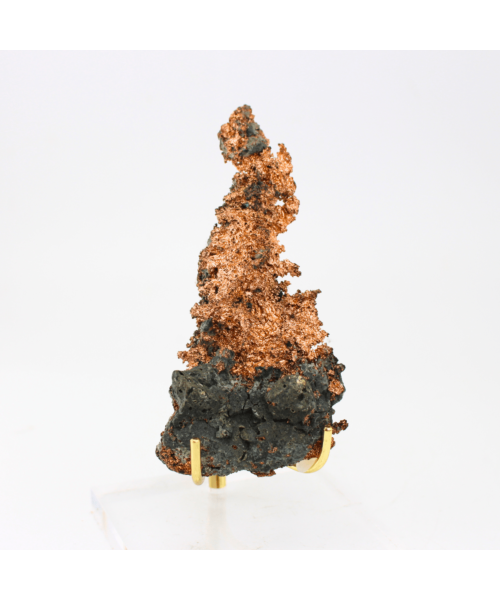Aragonite Naturally Terminated Gastein Austria 1498g
Aragonite Naturally Terminated Gastein Austria 1498g
Aragonite: The Radiant Crystal of Stability and Transformation Aragonite, a captivating carbonate mineral, showcases a distinctive crystal structure and a range of breathtaking colors. Named after the Aragon region in Spain where it was first discovered, aragonite is revered for its unique formations and associations with stability, transformation, and natural beauty. Physical Characteristics: Color: Aragonite exhibits a variety of colors, including white, brown, yellow, green, blue, and even pink. Its coloration is influenced by the presence of various impurities and inclusions. Transparency: Typically translucent to transparent, aragonite crystals often allow light to pass through, revealing their internal structures. Crystal System: Aragonite crystallizes in the orthorhombic system, forming elongated prismatic crystals with distinct striations. Crystal Habit: Aragonite crystals can take on various habits, including needle-like formations, radiating clusters, and stalactitic structures. It is known for its pseudohexagonal columnar crystals. Properties: Hardness: Aragonite is relatively soft, with a hardness of 3.5 to 4 on the Mohs scale, making it more susceptible to scratching compared to harder minerals. Cleavage: Aragonite exhibits perfect cleavage in three directions, contributing to its distinct crystal shapes. Luster: Its luster is vitreous to resinous, enhancing the visual appeal of its crystal surfaces. Locations: Aragonite is found in various geological settings around the world, with notable deposits in Spain, Italy, Mexico, the United States, and Namibia. Metaphysical and Symbolic Significance: Stability and Grounding: Aragonite is associated with stability and grounding energies, believed to bring a sense of balance and tranquility to those who possess or work with it. Transformation and Growth: In metaphysical practices, aragonite is thought to facilitate transformation and personal growth, encouraging individuals to overcome challenges and embrace positive change. Uses: Decorative Items: Aragonite's captivating crystal formations make it a popular choice for decorative items, including gemstone carvings, sculptures, and polished specimens. Jewelry: While not as commonly used in jewelry as harder gemstones, aragonite is occasionally crafted into beads or cabochons for unique and artistic pieces. Formation: Aragonite forms in various environments, including sedimentary rocks, hydrothermal veins, and the shells of marine organisms. Its presence in caves and other underground formations adds to its fascinating geological history. In summary, aragonite stands as a radiant mineral that not only showcases remarkable crystal structures but also carries symbolic significance associated with stability and positive transformation. Its diverse colors and formations contribute to its allure, making it a cherished addition to mineral collections and decorative pieces.| Weight (Grams) | 1498.000000 |
|---|---|
| Manufacturer | Imperial Time |
| Length (Depth) | 115mm |
| Width | 82mm |
| Height (mm) | 135mm |
| Main Stone | No Stone |
| Main Stone Creation | Natural |
| Total Carat Weight | 299 |
| Number of Diamonds | 0 |
| Number of Gemstones | 1 |
| Gemstone | No Stone |
| Certification | Imperial Time UK Ltd |
| Year | 2024 |
| Seller Waranty | 12-month |
We aim to deliver within 1-3 working days, Monday to Saturday, once payment has been received.
Free Click & Collect on all orders We offer free click & collect across the UK (excludes Ireland and the Channel Islands). Delivery times may vary depending on the product you select. You will be provided with an estimated delivery date once your order is confirmed. In general, your order will be delivered within 3-6 working days from being dispatched. We will email you when your order has been processed and again when your order has been dispatched. For more details, Contact with us.
Returns, Refund and Cancellation Policy
We operate a returns policy for unwanted and faulty goods. Should you need to return any item to us for any reason please contact us first by telephone or e-mail - see our Contact page.
Unwanted Goods
Please return goods unused and in original packaging in perfect condition for resale within (14) days of receipt. We recommend obtaining proof of postage. A full refund (minus the shipping costs) will be made on receipt of the returned goods.
Please note that you are responsible for shipping costs when returning unwanted goods.
What our customers are saying
Do you Have any Questions?
I would like to buy this item. How do I proceed?
To purchase this item:
- Click on ‘Add to Cart’ and then, ‘Proceed to Payment’.
- Enter your billing details and click on ‘Continue’.
- Enter your card details and click on ‘Pay for order’.
- We will ship your order after your payment is confirmed.
How is my order secure?
All our items are appropriately packaged and sent using Royal Mail Special Delivery insured, to ensure they don’t get damaged during transit.
When will I receive my order?
- Free Next Day Delivery On Selected Items – Order by 11 AM for delivery the following day, Monday –Friday.
- Free Standard Delivery – We aim to deliver any order outside the UK within 2-3 working days.
What payment method can I use?
We accept the following payment methods:
- Debit Card/ Credit Card (for both watches and jewellery)
- Cash upon collection.














Please complete your information below to login.
Sign In
Create New Account